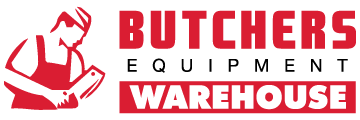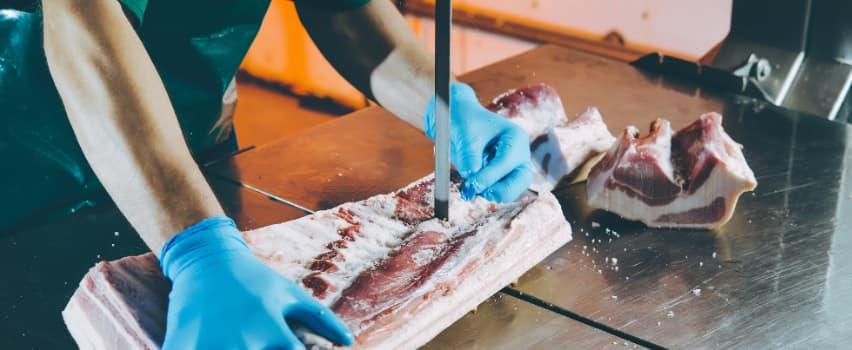When should you replace your butcher bandsaw blades?
Bandsaws are exceptionally useful for cutting through meat, bone, and frozen stock every day – which makes them a staple piece of machinery for any professional butchers workshop. And that means just like any vital tool, maintenance is an absolutely essential consideration. The bandsaw blade handles constant pressure, friction, and resistance, so they need to be consistently replaced to prevent avoidable disruptions to your work. If the blade runs too long, it can slow production, increase waste, and damage machines, so replacing it at the right moment essentially protects your output and keeps your team working safely and efficiently.
Happily, it’s not too tricky to tell when a blade needs to be replaced – there will be a variety of clean signs that demonstrate exactly when it’s reached the end of its service life. These include physical changes in the blade and shifts in cutting performance. So, if you need a couple of pointers, here’s what to look out for.
The cut quality drops off
Blades that stay on the saw too long start producing rough, uneven cuts. That’s generally clear to see in jagged edges, torn fibres, or uneven thickness in sliced sections. That can have a variety of consequences – potentially affecting their presentation quality, cause trimming waste, and if you’re unlucky, even a few customer complaints. You may also see changes in yield when a blade dulls. Poor-quality cuts increase offcuts and lower usable portions, which can force you to spend more time correcting the work.
A clean blade should glide through the cut and leave smooth surfaces across all sections. So if you or your staff see any visual or structural damage on meat cuts, the very next step should be to stop the saw and fit a fresh blade.
The blades start drifting or binding
Once a blade wears past its peak, it can begin to shift mid-cut. That means the blade no longer tracks cleanly through the meat, and starts veering sideways or flexing under pressure. You’ll generally feel this during use – you might notice the blade resisting direction, or cutting unevenly across a joint. These changes increase the risk of poor cuts and strain the bandsaw motor. Crucially, they can even be dangerous – you don’t need to be an expert to know that nobody wants a blade veering any place the operator doesn’t expect.
Binding on the other hand happens when the blade stalls or sticks partway through the material. This usually means the edge no longer bites cleanly, or the tension across the blade body has failed. When that happens, it increases heat, pressure, and friction in the machine. A blade that binds even once needs to be replaced as a priority, just the same as it does if it starts drifting. Prompt replacement is going to preserve your workflow, and most importantly, prevent health and safety risks for your team.
You’re working through bone or frozen meat
Dense material grinds blades down much faster than soft or boneless cuts. If you’re cutting through frozen blocks or bone-in joints, you’ll expose the blade to harder surfaces and greater resistance. That extra load wears the teeth, heats the blade, and risks cracks or fractures. In these cases, standard replacement intervals won’t match real wear rates.
So for that reason alone, if you’re handling frozen meat, lamb racks, pork shoulders, or beef hindquarters on a regular basis, it’s a good idea to factor this into your maintenance plan. If your team works with bone-heavy or frozen product more than once a day, ideally they should inspect blades more often and plan for earlier replacements. Blades that stay sharp in lighter work won’t last as long in dense material, so your team needs to adjust the schedule to match.
Output ramps up and blades wear faster
Production levels directly affect the life of your blade. That means – as you’d expect – the more your team runs the saw, the faster the blade wears out. If your shop increases its throughput for seasonal orders, regular contracts, or trade deliveries, you’ll need to ensure that you adapt your blade routines to match. High-volume output puts more pressure on the blade, shortens the life cycle, and increases the risk of breakdowns.
To avoid that, it’s a good idea for supervisors and shift leaders to check cutting totals each day and link those figures to blade performance. If your daily volume has doubled but the blade change schedule has stayed the same, the blades will fail sooner. Adjust your checks and changeover plan to reflect that new pace – that goes a long way towards helping to keep your cuts accurate and prevent production delays.
You notice any cracks, burning, or heat marks
This is perhaps the most obvious one, but still worth mentioning! Blades that show visible damage should come off the saw immediately. Your staff will see these signs as they work – small cracks along the edge, discolouration from heat, or dark burn marks across the teeth. These are all signs of stress fatigue or heat build-up from overuse. If the blade continues to run after these signs appear, that increases the chance of a full failure.
Make sure all your team members know how to spot and report early warning signs. If someone notices a crack or sees a discoloured patch where the blade passed through bone, they must remove it. Quick action from the floor keeps people safe and prevents more serious machine damage later. The people using the saw each day will notice these details before anyone else – so make sure that nobody is afraid to speak up.
And of course, if you’re looking to replace your meat bandsaw blades as soon as you can, or if you need to replenish your stock of spares, that’s exactly where we can help here at Butchers Equipment Warehouse. We've been stocking, supplying and manufacturing bandsaw blades for almost over 35 years, so we’ve built up a collection of bandsaw blades to suit all operations, whether you have a smaller machine or an industrial machine for larger-scale operations.
We also offer next-day delivery on our bandsaw blades, so if you need them quickly, give our team a call. If you have any questions or need advice, please don't hesitate to get in touch with us on 01254 427761!




